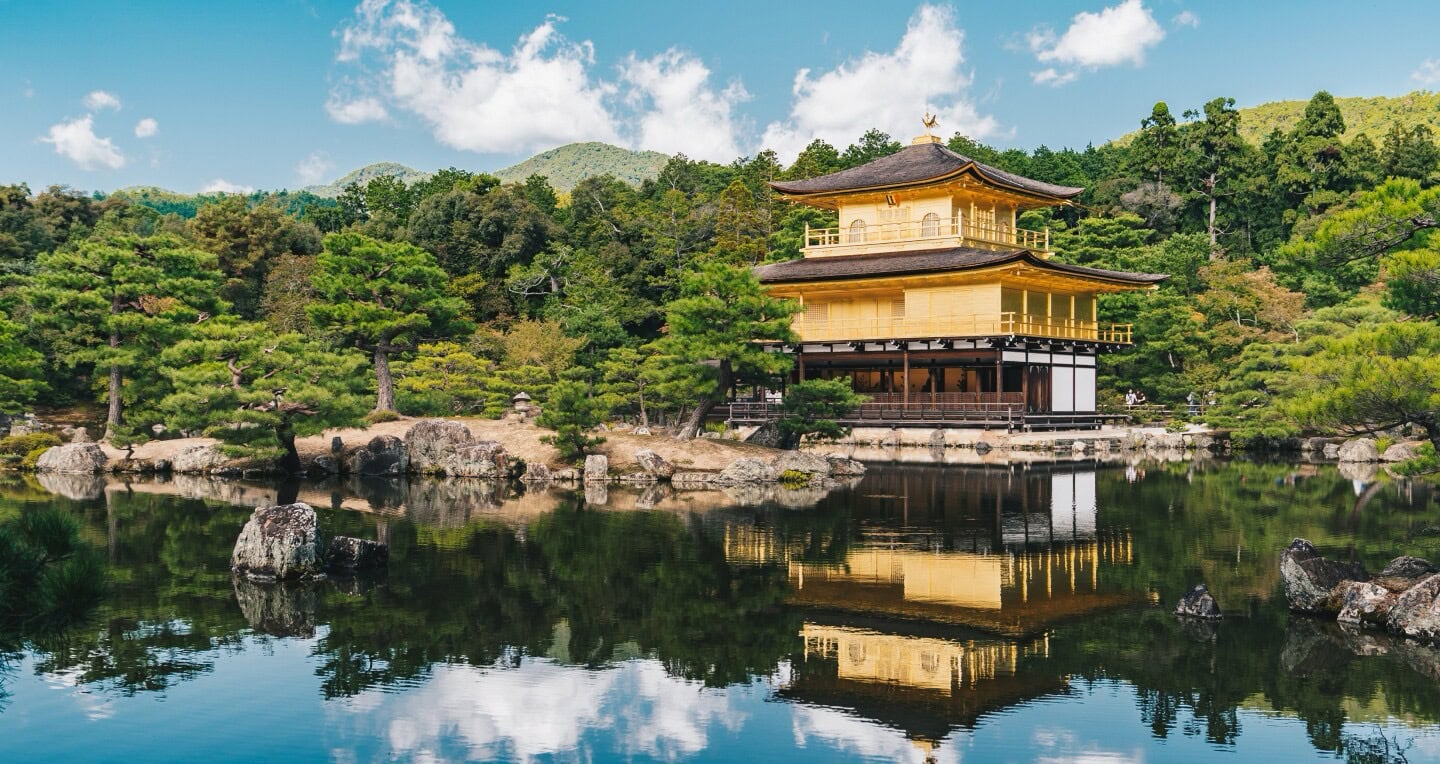
Kyoto is a city that changes its character with every season.
Once the imperial capital of Japan, it remains the cultural heart of the country, home to golden temples, tranquil gardens, geisha districts, and centuries-old festivals.
What makes Kyoto truly special, however, is how dramatically the city transforms throughout the year.
Cherry blossoms turn the streets into a sea of pink in spring, fiery maple leaves paint the temples red in autumn, and even the quiet winter months reveal a different side of Kyoto as snow dusts the rooftops of wooden townhouses.
That is why choosing the best time to visit Kyoto is one of the most important decisions you will make when planning your trip. Each season brings its own balance of climate, crowds, and cost.
In this guide, we will break down the seasons and months in Kyoto so you can align your trip with what matters most to you.
You will find practical details on weather, festivals, and crowd patterns, along with insider tips to help you save money, avoid the busiest times, and make the most of your visit.
Whether you are traveling for the cherry blossoms, the autumn leaves, or simply the chance to experience the traditions of Japan at their source, timing your visit wisely can turn a good trip into an unforgettable one.
Why Timing Your Kyoto Trip Matters

Kyoto is one of the few cities in the world where the seasons are not just weather patterns but defining cultural experiences.
From the delicate cherry blossoms of spring to the fiery autumn leaves that set temple gardens ablaze, the timing of your trip will shape every moment of your visit.
While the city is beautiful year-round, small shifts in the calendar can have a dramatic impact on what you see, how many people you share it with, and how much you pay.
When planning a trip to Kyoto, it helps to think about the “Three Cs” – Climate, Crowds, and Cost.
Climate
Kyoto enjoys a temperate climate with four distinct seasons:
- Spring (March to May) brings cherry blossoms and comfortable weather.
- Summer (June to August) can be hot and humid, with a rainy season in June and occasional typhoons in late summer.
- Autumn (September to November) offers crisp air and brilliant foliage.
- Winter (December to February) is chilly, with occasional snow that transforms the temples into serene, postcard-perfect scenes.
The climate is a defining factor in how you will experience the city – from hanami picnics in April to steaming bowls of ramen on a frosty February evening.
Crowds
Crowds in Kyoto rise and fall with the seasons.
The busiest periods are late March to early April (cherry blossoms) and mid to late November (autumn foliage). During these times, hotel rates soar, trains and buses are packed, and iconic temples like Kiyomizu-dera and Fushimi Inari can feel overwhelming.
On the other hand, visiting during winter or early summer often means quieter streets, fewer lines, and the chance to see Kyoto at a slower pace.
For many travelers, balancing natural beauty with manageable crowds is the key to choosing the best time to visit.
Cost
The hotel and flight prices for Kyoto follow the rhythm of the tourist seasons.
During sakura and autumn foliage peaks, rates can double, and availability for both hotels and award flights becomes scarce months in advance.
By contrast, January, February, June, and September often offer the best deals. These off-peak months not only mean lower prices but also better opportunities to redeem points and miles for premium stays.
For savvy travelers, timing a trip around the low seasons can stretch your budget significantly further.
The best time to visit Kyoto is not the same for everyone – it depends on whether your priority is catching cherry blossoms at their peak, saving money on accommodations, or wandering temple paths without the rush of tour groups.
Seasonal Breakdown: Weather, Crowds, And Costs
Kyoto is a destination that truly changes with the seasons.
But these seasonal shifts also affect weather, visitor numbers, and travel costs. Understanding how these three factors line up throughout the year will help you choose the best time to visit Kyoto for your personal travel style.
Winter In Kyoto (December – February)

Winter in Kyoto offers a quieter, more contemplative side of the city. While cold weather keeps many tourists away, those who visit during this season enjoy peaceful temples, clear skies, and the lowest hotel rates of the year.
- Weather: Average highs hover around 9 – 11°C (48 – 52°F) with lows near 1 – 3°C (34 – 37°F). Snow is rare in central Kyoto but possible in surrounding areas like Kurama, Ōhara, and Mt Hiei. Days are crisp and often sunny, perfect for sightseeing if you dress warmly.
- Crowds and Costs: Aside from New Year’s week (December 29 – January 3), winter is one of the least crowded seasons in Kyoto. Hotels and flights are at their cheapest, making this the best time for budget travelers.
- Why Visit: Winter highlights include shrine visits during Hatsumode (New Year), the Toshiya Archery Contest in January, and the Setsubun Fire Festival in February. Snow-dusted temples like Kinkaku-ji or Fushimi Inari (if you are lucky with timing) create postcard-worthy scenes. It is also the perfect season to warm up with a matcha tea ceremony or relax in a nearby onsen.
Spring In Kyoto (March – May)
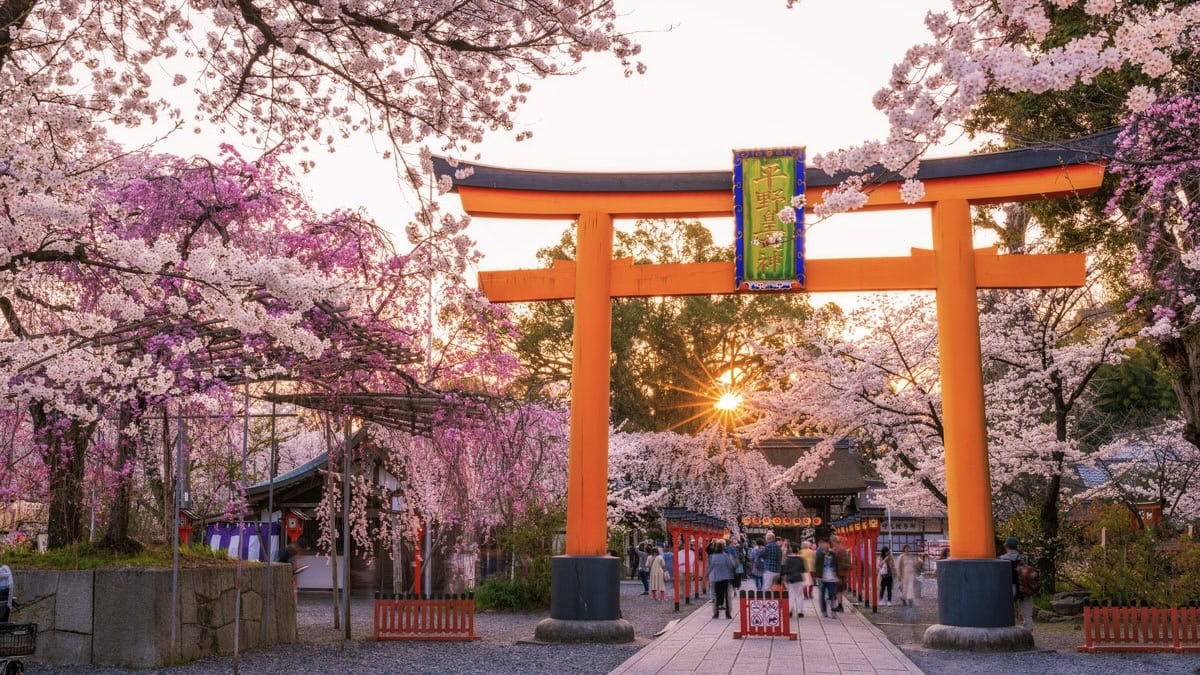
Spring is the most famous season in Kyoto, drawing visitors from around the world to see the cherry blossoms in full bloom. While this is the busiest and most expensive time to visit, the beauty of the city draped in pink petals makes it unforgettable.
- Weather: Average highs range from 13°C (56°F) in March to 24°C (76°F) in May. Early spring can still feel chilly, but by May the weather is warm and comfortable. Light layers are best for changing conditions.
- Crowds and Costs: Late March through early April is peak cherry blossom season, making it the most crowded and expensive time of year. Hotels book out months in advance. After the blossoms fade, crowds ease until early May’s Golden Week, when domestic travelers flood the city and prices spike again. Late May is quieter and more affordable.
- Why Visit: Cherry blossom viewing, or hanami, is the star attraction – top spots include Maruyama Park, the Philosopher’s Path, and even boat rides on the Lake Biwa Canal. Plum blossoms in March and vibrant new greenery in May also create stunning scenery. Spring festivals like the Aoi Matsuri (May) and Yabusame horseback archery add cultural depth to the season.
Summer In Kyoto (June – August)
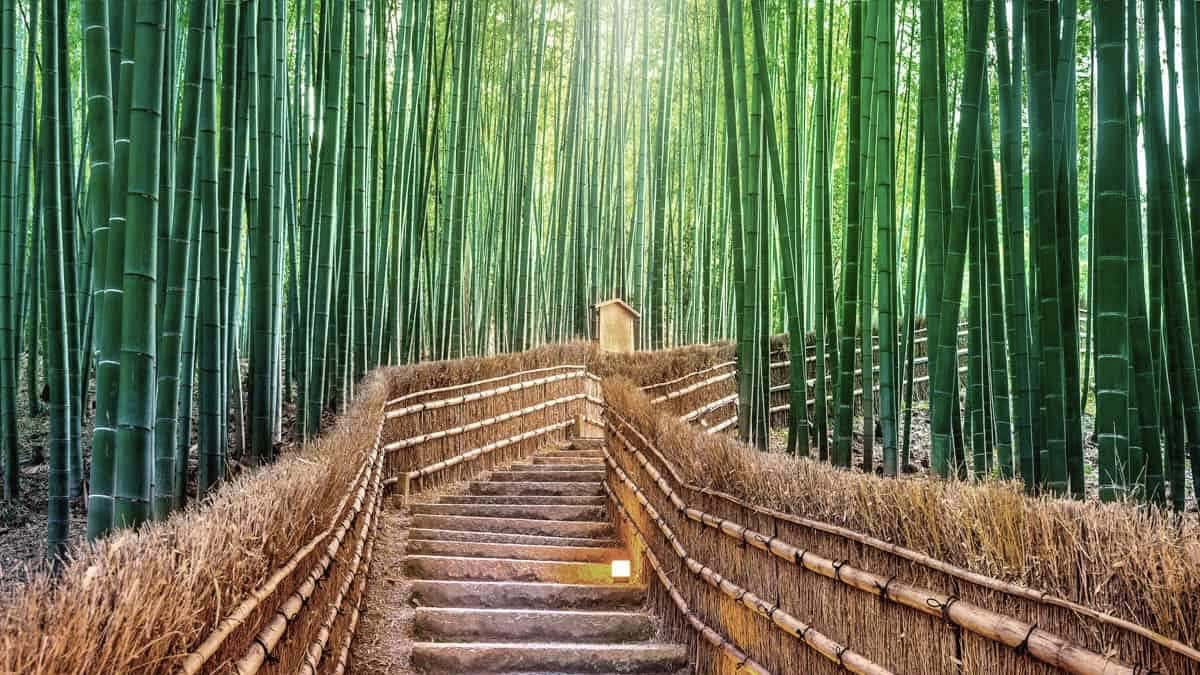
Summer in Kyoto is a season of contrasts – lush gardens and vibrant festivals balanced against heavy humidity and sweltering heat. While not ideal for weather-sensitive travelers, it offers some of the city’s most exciting cultural events and better deals on accommodations.
- Weather: June begins with the rainy season, bringing warm days (average highs around 27°C / 82°F) and afternoon showers. By July and August, temperatures climb to 31 – 33°C (88 – 91°F) with high humidity, and typhoons are possible in late summer.
- Crowds and Costs: Crowds are lighter than in spring and autumn, making summer a good time to secure hotel deals and award redemptions. Exceptions are festival days, especially in July, when locals and domestic tourists join the celebrations.
- Why Visit: Summer is festival season in Kyoto. The Gion Matsuri in July, with its massive floats and street parties, is one of the most famous events in Japan. August brings the Daimonji Fire Festival, where giant bonfires are lit on the surrounding mountains. Visitors can also enjoy riverside dining in Kibune, shaded strolls through Arashiyama’s bamboo grove, and colorful hydrangeas blooming at temples like Sanzen-in.
Autumn In Kyoto (September – November)
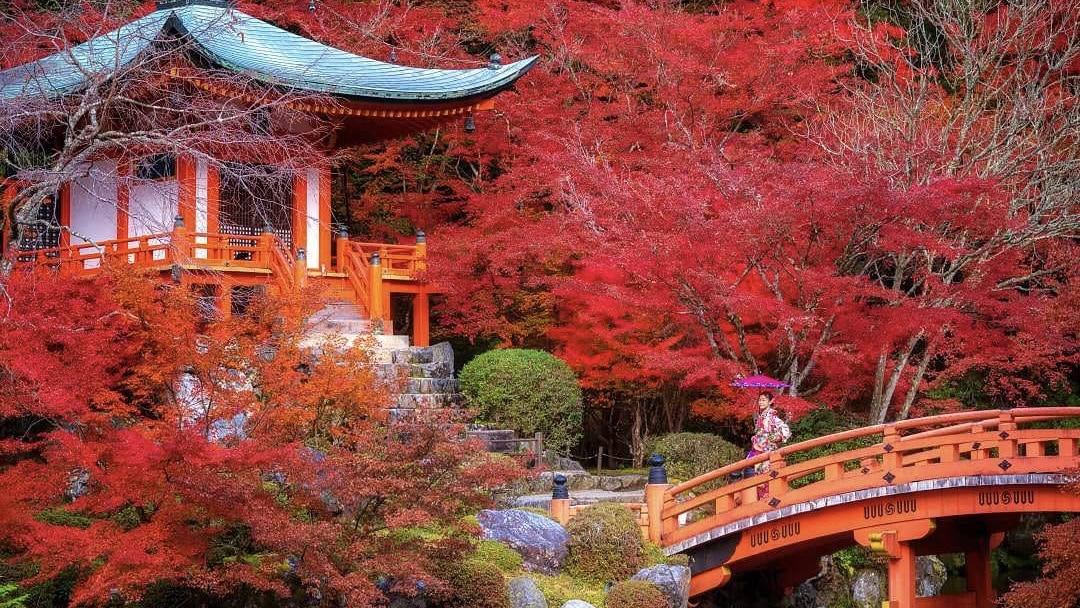
Autumn is the rival of spring as the most beautiful season in Kyoto. While September begins hot and humid, by October the weather turns crisp and comfortable. November brings spectacular fall foliage, making it one of the busiest and most photogenic times to visit.
- Weather: September averages highs around 28°C (83°F) and can still feel humid, with occasional typhoons early in the month. By October, temperatures drop to the low 20s°C (70s°F), and November cools further to 17°C (62°F) with crisp, sunny days.
- Crowds and Costs: September is considered low season, offering bargains on hotels and flights. October sees moderate crowds with events like the Jidai Matsuri. By mid to late November, autumn leaves reach their peak, and Kyoto becomes extremely crowded and expensive – second only to cherry blossom season.
- Why Visit: The main draw is the autumn foliage, or koyo, which transforms temples like Kiyomizu-dera, Tenryu-ji, and Yoshimine-dera into fiery landscapes. Evening illuminations at temples such as Eikan-dō and Kōdai-ji add a magical after-dark experience. The Jidai Matsuri (Festival of the Ages) and Kurama Fire Festival in October provide cultural highlights alongside the seasonal beauty.
Kyoto Weather By Month
The four seasons in Kyoto are well-defined, and each month brings its own rhythm of climate, events, and crowds. This breakdown helps you match your trip to the experience you want most – whether that is cherry blossoms, autumn foliage, or quiet winter mornings.
| Month | Avg High / Low (°C) | Rainfall | Key Events & Highlights | Crowd Levels |
| January | 9 / 1 (48 / 34°F) | Low | New Year shrine visits (Hatsumode), Toshiya Archery Contest | Low after New Year |
| February | 10 / 2 (50 / 34°F) | Low | Setsubun Fire Festival, early plum blossoms | Low |
| March | 13 / 4 (56 / 39°F) | Moderate | Plum blossoms, early cherry blossoms, Hanatoro | Rising late March |
| April | 19 / 9 (67 / 48°F) | Moderate | Peak cherry blossoms, hanami picnics | Very High |
| May | 24 / 14 (76 / 57°F) | Moderate | Golden Week, Aoi Matsuri, Yabusame Archery | High early May, lower after |
| June | 27 / 18 (82 / 65°F) | High | Rainy season, hydrangeas, Takigi Noh | Low |
| July | 31 / 23 (88 / 73°F) | High | Gion Matsuri, end of rainy season | Moderate (high during festival) |
| August | 33 / 24 (91 / 75°F) | High | Daimonji Fire Festival, riverside dining | Moderate |
| September | 28 / 20 (83 / 68°F) | High | Transition to autumn, fewer tourists | Low |
| October | 22 / 13 (73 / 56°F) | Moderate | Jidai Matsuri, Kurama Fire Festival | Moderate |
| November | 17 / 8 (62 / 46°F) | Moderate | Peak autumn foliage | Very High |
| December | 11 / 3 (52 / 37°F) | Low | Early foliage, Christmas lights, New Year’s Eve temple bells | High early Dec, Low late Dec |
Best Time To Visit Kyoto For Specific Experiences
Kyoto is beautiful year-round, but some experiences truly shine in specific seasons. Matching your trip to the sights and events you want most will help you make the most of your time in the cultural capital of Japan.
Cherry Blossom Viewing In Kyoto
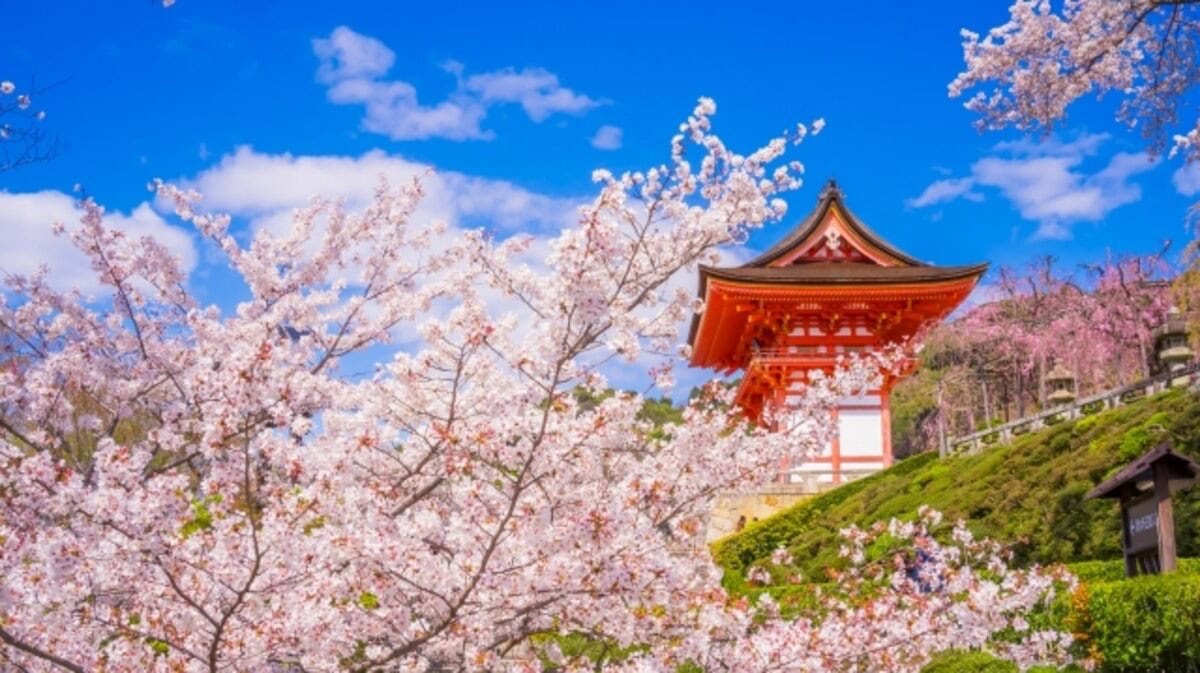
Cherry blossoms, or sakura, are the most iconic reason to visit Kyoto in spring. The city becomes a sea of pink, drawing visitors from around the world.
Key Information
- Best Time to Visit: Late March to early April (bloom timing shifts each year).
- Best Spots: Maruyama Park, Philosopher’s Path, Kamo River, and the hidden gem Lake Biwa Canal cruise.
- What to Expect: Hanami picnics under the blossoms, festive atmosphere, and very large crowds at famous temples.
- Insider Tip: Check the Kyoto cherry blossom forecast before your trip, and aim for early morning or evening visits to avoid peak crowds.
Autumn Foliage (Koyo) In Kyoto
Autumn in Kyoto rivals spring in beauty, as maple leaves turn fiery shades of red and gold.
Key Information
- Best Time to Visit: Mid to late November.
- Best Spots: Kiyomizu-dera, Arashiyama, Yoshimine-dera, Tenryu-ji, plus evening illuminations at Eikan-dō and Kōdai-ji.
- What to Expect: Stunning landscapes, crisp weather, and very heavy crowds at peak.
- Insider Tip: Visit less popular temples like Yoshimine-dera for spectacular foliage with fewer tourists.
Festivals And Cultural Events In Kyoto

The festivals in Kyoto bring history and tradition to life, with processions, performances, and community celebrations.
Key Information
- Best Time to Visit: Year-round, but highlights include:
- May: Aoi Matsuri (imperial procession in Heian dress)
- July: Gion Matsuri (giant floats, street parades)
- August: Daimonji Fire Festival (mountainside bonfires)
- October: Jidai Matsuri (Festival of the Ages, historic costumes)
- What to Expect: Large crowds of locals and tourists, vibrant parades, food stalls, and cultural immersion.
- Insider Tip: Book accommodations months in advance – especially for Gion Matsuri in July.
Photography And Tranquil Temple Visits
If your goal is to experience the temples and gardens of Kyoto at their most peaceful, timing is everything.
Key Information
- Best Time to Visit: Winter (January – February) and shoulder seasons (late April, early December).
- Best Spots: Fushimi Inari Shrine at sunrise, Arashiyama Bamboo Grove early morning, lesser-known temples like Tofuku-ji and Nanzen-ji.
- What to Expect: Quiet streets, crisp air, and better opportunities for photography without heavy crowds.
- Insider Tip: Start your day before 8 a.m. to enjoy the iconic Kyoto spots in relative solitude.
Budget-Friendly Travel In Kyoto
Traveling in the off-season offers lower costs and fewer crowds.
Key Information
- Best Time to Visit: January, February, June, September.
- What to Expect: Lower hotel prices, better flight deals, and easier award bookings. June brings hydrangea blooms, while September offers warm weather at bargain prices.
- Insider Tip: Use points and miles to book hotels during spring and autumn peaks, and save cash stays for off-season travel.
How To Save On Flights, Hotels, And Activities In Kyoto

Kyoto is not only about timing your trip for blossoms or foliage – it is also about planning smartly to save money, avoid the heaviest crowds, and experience the city more authentically.
By knowing when to book and how to structure your trip, you can enjoy Kyoto at its very best.
Travel In The Shoulder Season
The shoulder seasons in Kyoto – the quiet weeks between peak sakura and foliage rush – offer a balance of good weather, manageable crowds, and lower costs.
Key Information
- Best Months: Late April to May, September, and early December.
- Weather: Mild temperatures, with spring greenery or early autumn colors.
- Crowds: Smaller than in cherry blossom or foliage season.
- Savings: Hotels and flights are often 20 – 30% cheaper compared to peak season.
- Insider Tip: September is especially underrated – warm weather, low prices, and a relaxed vibe before the foliage season.
Book Flights Early
Flights to Japan can fluctuate dramatically depending on the season, but early booking almost always means better deals.
Key Information
- Best Booking Window: 4 – 8 months before travel.
- Cheapest Days to Fly: Midweek departures (Tuesday and Wednesday).
- Award Travel Tip: Popular routes like Tokyo to Kyoto sell out quickly in peak spring and autumn.
- Insider Tip: Consider flying into Osaka (KIX) instead of Tokyo (HND and NRT) for cheaper fares and a faster connection to Kyoto.
Use Points And Miles Strategically
Kyoto hotel prices soar during cherry blossom and foliage seasons. Using points and miles can help offset these peak costs.
Key Information
- Best Time to Use Points: March and April (cherry blossoms) and November (autumn foliage).
- Best Time to Pay Cash: January, February, June, and September, when rates are lowest.
- Booking Strategy: Lock in award stays up to a year in advance for peak dates.
- Insider Tip: Kyoto hotels book up quickly – consider staying in Osaka and taking a day trip (30 – 45 minutes by train) if Kyoto is sold out.
Consider Alternative Stays
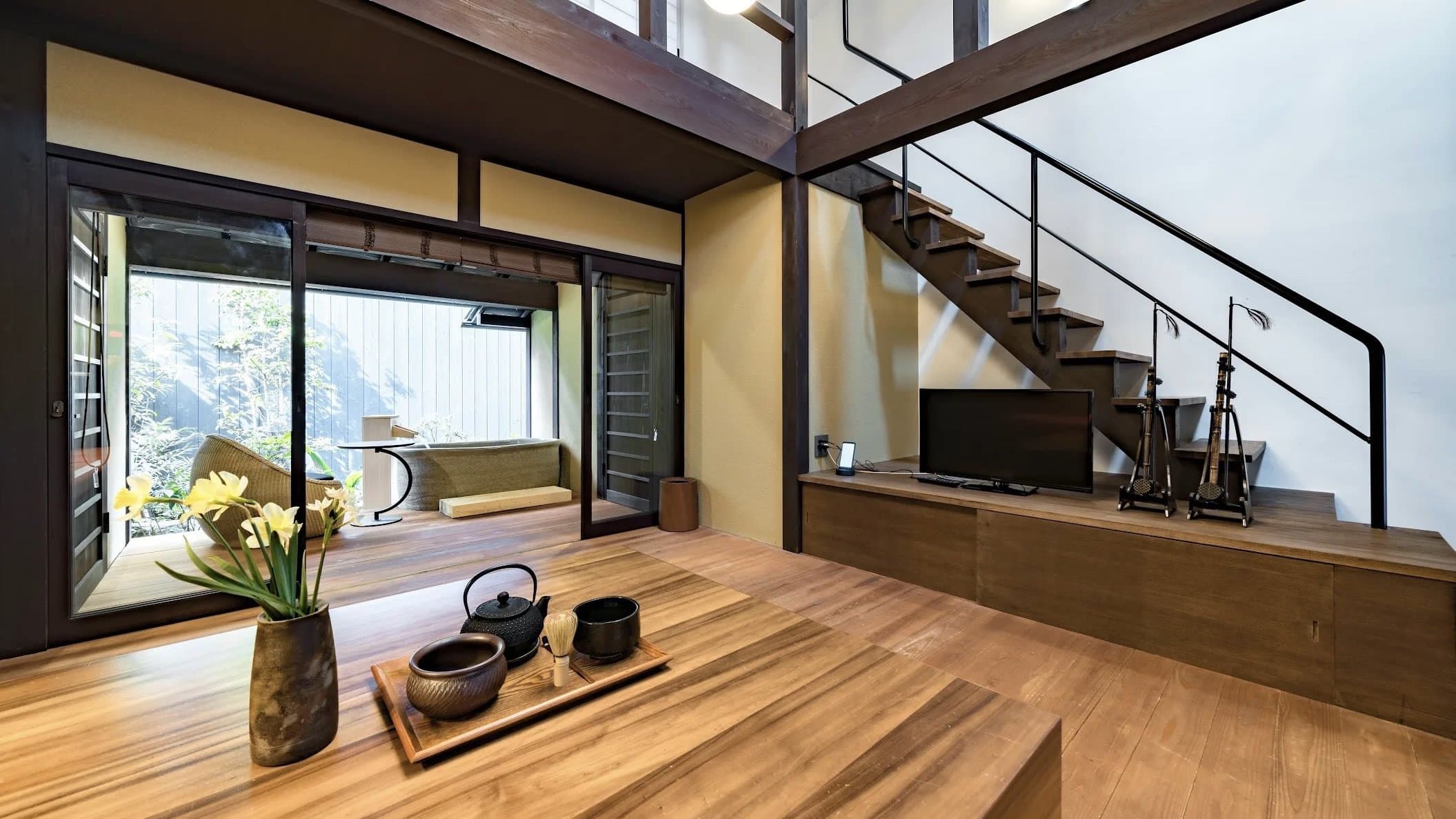
Vacation rentals and guesthouses offer a different way to experience Kyoto while often saving money.
Key Information
- Best Time for Savings: January, February and September.
- Platforms: Airbnb, Vrbo, and local Japanese booking sites like Rakuten Travel.
- Average Savings: Up to 40% less than hotels during off-season.
- Extra Perks: Kitchens, tatami mat rooms, and a more local neighborhood feel.
- Insider Tip: Machiya (traditional townhouses) rentals are a great way to immerse yourself in old Kyoto charm.
Prepare For Weather Shifts
The climate in Kyoto varies dramatically across the seasons, so packing smart is essential.
Key Information
- Spring: Light jacket for cool evenings.
- Summer: Breathable clothing and an umbrella for sudden showers.
- Autumn: Layers for crisp mornings and evenings.
- Winter: Warm coat and gloves for temple visits in the hills.
- Insider Tip: Always carry a compact umbrella – the weather in Kyoto can change quickly, especially in the June rainy season.
Other Considerations Before You Book
Choosing the best time to visit Kyoto is not just about weather or festivals. A few cultural, practical, and logistical factors can make a big difference in how smooth and rewarding your trip feels.
Here are the key things to keep in mind before you finalize your travel dates.
Public Holidays & Golden Week
Japan has several national holidays that can dramatically impact your Kyoto trip.
Key Information
- Golden Week (Late April – Early May): One of the busiest travel periods in Japan. Trains, hotels, and attractions are packed, and prices are at their highest.
- Obon (Mid-August): A Buddhist holiday when many Japanese return to their hometowns. Kyoto hosts the Daimonji Fire Festival, but travel is crowded and expensive.
- New Year (Late December – Early January): Many businesses close, but shrines like Fushimi Inari and Heian Shrine fill with locals making their first shrine visits of the year.
- Insider Tip: If you are traveling during these holidays, book trains and accommodations well in advance.
Temple & Shrine Etiquette

Kyoto is a living cultural capital, not just a tourist destination. Respectful behavior ensures you have a more authentic and positive experience.
Key Information
- Dress Code: Cover shoulders and knees when entering temples.
- Photography: Always ask before photographing monks, geisha, or inside temple halls.
- Shoes: Be prepared to remove shoes at many temples and traditional restaurants.
- Insider Tip: Arrive early in the morning at popular spots like Arashiyama Bamboo Grove or Fushimi Inari – you will enjoy both better photos and a more respectful experience.
Transportation & Accessibility
Kyoto is compact but packed with sights, so understanding transport can save you time and frustration.
Key Information
- Trains & Buses: The Kyoto subway is limited; buses and trains are essential for temple-hopping.
- Japan Rail Pass: Worth it if you are visiting multiple cities (i.e. Tokyo, Osaka, Hiroshima, etc.), but not necessary for a Kyoto-only trip.
- Bicycles: A great way to explore flat areas like Gion and the Philosopher’s Path.
- Insider Tip: Buy an ICOCA prepaid transit card for seamless travel on trains, buses, and even in convenience stores.
Responsible Travel In Kyoto
Overtourism has become a challenge in Kyoto, especially in historic districts like Gion. Traveling responsibly helps preserve the cultural heritage of the city.
Key Information
- Support Local: Eat at family-run restaurants and shop at traditional craft stores.
- Stay Considerate: Avoid blocking streets in Gion when hoping to see geiko (geisha). Many alleys are residential.
- Eco-Friendly: Bring a reusable bottle; Kyoto tap water is safe to drink.
- Insider Tip: Consider exploring lesser-known neighborhoods like Uji (famous for matcha) or Ohara (rural temples and gardens) to reduce pressure on central Kyoto.
Final Thoughts
Kyoto is a city that feels alive with the rhythm of the seasons.
Each visit reveals a new side of its beauty, from the pink glow of cherry blossoms in spring to the fiery hues of autumn leaves, from summer nights filled with festival lanterns to the quiet elegance of temples dusted with snow.
Choosing when to go is less about finding a single “best” time and more about matching the season to the kind of experience you hope to have.
For many, spring and autumn stand out as the most enchanting times to be in Kyoto. The blossoms and fall colors create unforgettable backdrops for exploring the city’s shrines, gardens, and historic streets.
These are also the busiest months, so planning ahead is essential.
Yet the quieter months of winter and the lush greenery of the rainy season offer their own rewards, from peaceful temple visits to lower prices and fewer tourists.
Summer, while hot and humid, is alive with tradition, festivals, and vibrant energy that provide a different kind of magic.
No matter the season, the timeless beauty of Kyoto, deep traditions, and warm hospitality create experiences that linger long after you leave.
With thoughtful timing and a spirit of openness, every trip to Kyoto can feel like the perfect one.